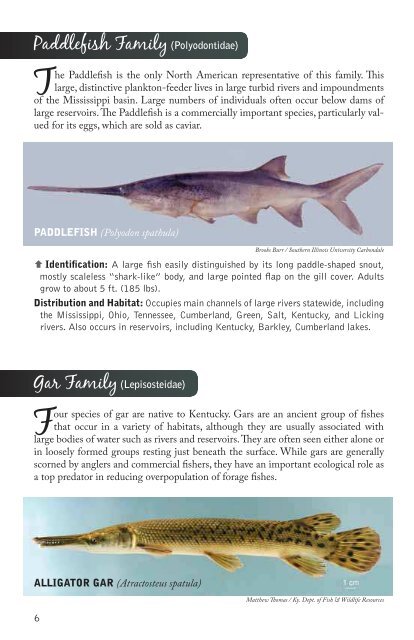Kentucky Fishes
kyfishid[1]
kyfishid[1]
- No tags were found...
You also want an ePaper? Increase the reach of your titles
YUMPU automatically turns print PDFs into web optimized ePapers that Google loves.
Paddlefish Family (Polyodontidae)<br />
The Paddlefish is the only North American representative of this family. This<br />
large, distinctive plankton-feeder lives in large turbid rivers and impoundments<br />
of the Mississippi basin. Large numbers of individuals often occur below dams of<br />
large reservoirs. The Paddlefish is a commercially important species, particularly valued<br />
for its eggs, which are sold as caviar.<br />
SPOTTED GAR (Lepisosteus oculatus)<br />
LONGNOSE GAR (Lepisosteus osseus)<br />
Matthew Thomas / Ky. Dept. of Fish & Wildlife Resources<br />
SHORTNOSE GAR (Lepisosteus platostomus)<br />
Matthew Thomas / Ky. Dept. of Fish & Wildlife Resources<br />
PADDLEFISH (Polyodon spathula)<br />
Ç Identification: A large fish easily distinguished by its long paddle-shaped snout,<br />
mostly scaleless “shark-like” body, and large pointed flap on the gill cover. Adults<br />
grow to about 5 ft. (185 lbs).<br />
Distribution and Habitat: Occupies main channels of large rivers statewide, including<br />
the Mississippi, Ohio, Tennessee, Cumberland, Green, Salt, <strong>Kentucky</strong>, and Licking<br />
rivers. Also occurs in reservoirs, including <strong>Kentucky</strong>, Barkley, Cumberland lakes.<br />
Gar Family (Lepisosteidae)<br />
Four species of gar are native to <strong>Kentucky</strong>. Gars are an ancient group of fishes<br />
that occur in a variety of habitats, although they are usually associated with<br />
large bodies of water such as rivers and reservoirs. They are often seen either alone or<br />
in loosely formed groups resting just beneath the surface. While gars are generally<br />
scorned by anglers and commercial fishers, they have an important ecological role as<br />
a top predator in reducing overpopulation of forage fishes.<br />
ALLIGATOR GAR (Atractosteus spatula)<br />
Brooks Burr / Southern Illinois University Carbondale<br />
Matthew Thomas / Ky. Dept. of Fish & Wildlife Resources<br />
ALLIGATOR<br />
SHORTNOSE<br />
SPOTTED<br />
LONGNOSE<br />
Eugene Beckham / Northwood University<br />
Matthew Thomas / Ky. Dept. of Fish & Wildlife Resources<br />
Ç Identification: All gars have long and slender<br />
bodies, beak-like jaws, and large, diamond-shaped<br />
scales. Alligator Gar is the largest species, reaching<br />
9 ft. (300 lbs). It is distinguished from other gars<br />
by its short, broad snout, and heavy body. Spotted<br />
Gar has a unique pattern of large spots on the top of<br />
head and body. Shortnose Gar is similar to Spotted<br />
Gar, but lacks spots on head and body. Both species<br />
are usually less than 3 ft. (5-10 lbs). Longnose Gar<br />
is easily distinguished from other gars by having an<br />
extremely long and narrow snout. It can grow to 6<br />
ft. (50 lbs). Differences in head shape among the<br />
four species of gar are illustrated at left.<br />
Distribution and Habitat: Longnose Gar is common<br />
statewide in streams, rivers, and reservoirs. Spotted<br />
Gar and Shortnose Gar occur in the Ohio and Mississippi<br />
Rivers and in western <strong>Kentucky</strong>, from the lower<br />
Green River basin to the Mississippi River. Alligator<br />
Gar once occurred in the Ohio and Mississippi<br />
Rivers and in backwaters and embayments along the<br />
lower Ohio and Mississippi River floodplains in western<br />
<strong>Kentucky</strong>. The <strong>Kentucky</strong> Department of Fish and<br />
Wildlife Resources is working to re-establish populations<br />
to these former native habitats.<br />
6 7



